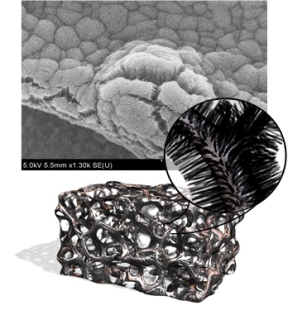Nov 12 2014
A team of University of Maryland researchers is growing vertically aligned “forests” of carbon nanotubes on three-dimensional (3-D) conductive substrates to explore their potential use as a cathode in next-gen lithium batteries.
 Forests of carbon nanotubes grown directly on nickel foam as a next-generation battery electrode. (Maryland Nanocenter)
Forests of carbon nanotubes grown directly on nickel foam as a next-generation battery electrode. (Maryland Nanocenter)
During the AVS 61st International Symposium & Exhibition, being held November 9-14, 2014, in Baltimore, Md., the team will describe their process for creating lithium-oxygen (Li-O2) battery cells.
Carbon nanotubes are typically grown on two-dimensional or planar substrates, but the structure developed by the team is considered “3-D” because the carbon nanotubes are grown on a porous, “sponge-like” foam structure made of nickel coated with aluminum oxide ceramic.
Batteries usually consist of an anode, cathode and electrolyte; the researchers’ 3-D structure forms the “cathode” part of the battery.
“Our team developed self-standing, catalyst-decorated carbon nanotube cathodes for Li-O2 batteries using atomic layer deposition (ALD) and electrochemical deposition methods,” said Marshall Schroeder, a member of the Rubloff Research Group in Materials Science and Engineering at the University of Maryland. “And we also have unique capabilities for in situ characterization via scanning electron microscopy and X-ray photoelectron spectroscopy for elemental analysis of pristine electrodes and at different points during cycling.”
How does the team build their battery cathode? First, they use a nickel foam current collector to deposit a thin layer (~5nm) of aluminum oxide using ALD. This is chased by a layer of iron, sputtered as a growth catalyst for chemical vapor deposition (CVD) of carbon.
The ALD layer “acts as a diffusion barrier to keep the growth catalyst from diffusing into the nickel foam during the high-temperature carbon growth process,” Schroeder explained. “The type of carbon growth is heavily dependent on the CVD process parameters—catalyst ripening temperature/time, growth time/temperature, precursor type, and flow rate, etc.—so optimization of the growth process was required to achieve a vertically aligned carbon nanotube architecture.”
These structures were put to the test as cathodes in lithium oxygen cells, and the team discovered that the optimized growth process resulted in a hierarchical pore structure featuring dense carpets of vertically aligned carbon nanotubes on a 3-D current collector scaffold.
Preliminary studies of this cathode structure show promising results for oxygen reduction reaction (ORR) performance, according Schroeder. “For the oxygen evolution reaction (OER), continued studies will focus on optimization of the electrode performance via decoration with ALD-deposited catalysts,” he adds. “We’ve also started studying the catalyst performance on other carbon nanotube substrates and now have a preliminary fundamental understanding of the catalyst chemistries developed by our team.”
The team’s work shows that combining their ALD capabilities with the unique structure of the 3-D cathode may “significantly improve the performance of one of the most promising next-generation lithium battery technologies,” Schroeder noted.